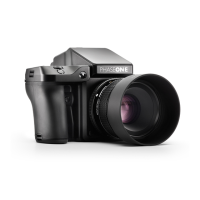
Do you have a question about the PhaseOne XF IQ4 and is the answer not in the manual?
| Sensor Type | CMOS |
|---|---|
| Sensor Size | 53.4 x 40.0 mm |
| Camera Format | Medium Format |
| Dynamic Range | 15 stops |
| Shutter Speed | 60 minutes to 1/4000 second |
| Display | 3.2 inch Touchscreen LCD |
| Storage Media | SD |
| Connectivity | USB-C, Ethernet, Wi-Fi |
| Battery | Rechargeable Li-ion Battery |
| LCD Resolution | 2.36 million dots |
| Lens Mount | XF Mount |
| Viewfinder | Optional |
| ISO Sensitivity | ISO 50-25600 |
Identifies the main physical components of the camera system.
Details the physical controls on the camera body.
Explains the primary interface elements on the top screen.
Guides on reassigning functions to physical controls.
Explains the operation and features of the touch screen interface.
Details the function and customization of the camera's dials and keys.
Describes the function of various camera body controls.
Explains touch gestures and modes for operating the IQ4.
How to access menus, tools, and status information on the IQ4.
Information displayed in the status bar and how to access menus.
The main interface for adjusting camera settings and capturing images.
Activating and using the live view feature on the IQ4.
How to view captured images individually on the IQ4.
Displaying metadata and exif data for captured images.
Using masks to check and ensure correct exposure.
Visualizing exposure range and highlight clipping.
How to set and save custom white balance settings.
Viewing metadata like rating, file name, and storage data in browser.
Adjusting shutter speed, aperture, and ISO settings.
Selecting and initiating various capture modes.
Using the virtual horizon for accurate leveling.
Merging multiple captures to simulate long exposures.
Displaying brightness data and channel information for exposure analysis.
Visualizing exposure masks to check for clipping.
Adjusting exposure settings directly within Live View.
Using focus peaking to aid manual focusing.
Optimizing Live View image brightness for better visibility.
Connecting the IQ4 to an external monitor via HDMI.
Activating the HDMI output for mirroring the screen.
Setting different security levels for IQ4 access.
Procedures for creating or changing the security code.
Restricting tethering access with a code.
Overview of available Intelligent Image Quality (IIQ) RAW formats.
Configuring how captured images are stored.
Options for saving images to the SD card.
Automatically copying RAW files to a computer.
Setting up tethering via Gigabit Ethernet.
Setting up fast tethering using a USB-C connection.
Enabling and configuring wireless tethering over Wi-Fi.
Utilizing PoE for powering the camera system.
Leveraging USB-C for power delivery.
Enabling sharing of power between the camera body and IQ4.
Procedure for replacing batteries without shutting down.
Steps to capture and create a custom white balance.
Enabling automatic saving of custom white balance settings.
Understanding and adjusting the autofocus area display.
Adjusting the viewfinder for clear viewing with corrective lenses.
Overview of default and customizable settings on the XF Body.
Adjusting ISO sensitivity and auto ISO settings.
Selecting between Single and Continuous AF drive modes.
Configuring the autofocus area for precise focusing.
Choosing between Manual, Aperture Priority, Shutter Priority, and Program modes.
Overview of available autofocus drive modes.
Setting AF priority to Release or Focus for shutter release.
Understanding Average and Spot AF area modes.
Locking focus position for off-center subjects.
Fine-tuning AF sensor accuracy manually.
Initial steps for preparing and setting up the focus trim process.
Fine-tuning focus using Live View or Capture One Pro.
Activating AFr mode for focus compensation during recomposition.
Understanding visual and audible feedback for AFr mode success.
List of lenses compatible with Autofocus & Recompose mode.
Explanation of hyperfocal distance for landscape photography.
Storing and recalling specific hyperfocal distances.
Basic operation for capturing a single image.
Capturing images continuously at the fastest frame rate.
Using vibration delay for stable captures.
Capturing a series of shots at different exposures.
Selecting between Manual, Av, Tv, and P exposure modes.
Configuring and using the auto ISO feature.
Temporarily switching to automatic exposure for a single shot.
Adjusting exposure compensation values in different modes.
Minimizing noise in long exposures by subtracting dark frames.
Activating and using the electronic shutter feature.
Controlling ES via IQ4 without the XF Body.
Extending dynamic range by combining two exposures.
Wireless control of Profoto Air flashes and settings.
Visualizing flash output, duration, and timing.
Adjusting flash sync timing for rear curtain sync.
Understanding shutter types and sync speed limitations.
Differences and advantages of FPS and LS lenses.
Steps for installing Capture One Pro on macOS.
Steps for installing Capture One Pro on Windows.
Minimum and recommended system specifications for Capture One.
Process for activating Capture One Pro software.
Connecting and controlling the camera via Capture One.
Importing captured images into Capture One.
Obtaining and installing the Capture Pilot app.
Establishing a connection between IQ4, computer, and mobile device.
Steps to create an LCC profile using reference captures.
Applying a created LCC profile to images.
Saving and reusing custom camera settings.
Backing up custom setups to an XQD or SD card.
Restoring custom setups from memory cards.
Resetting camera settings to factory defaults.
Guidelines for cleaning the camera body, lenses, and screens.
Step-by-step guide for cleaning the digital back sensor.
Verifying the operational status of system components.
Understanding and responding to system error messages.
Procedure for installing firmware updates.
Guide for replacing the focusing screen for older models.
Guide for replacing the focusing screen for newer models.
Information on contacting customer support and service.
How to get technical support for hardware and software.